To create a new e-mail campaign, go to the 'Manage e-mail campaigns'
application (
Catalog > E-mails > Manage e-mail campaigns).
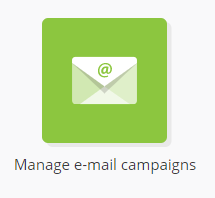
Click on the '+ Create a new campaign' button.

Choosing the campaign type
Next, you will have to choose the type of campaign that you want
to create.

There are 4 different types of campaigns :
-
One shot:
This type of campaign is sent at given time to a great
number of profiles all at once.
-
Scenarized:
This type of campaign can be triggered automatically via
Scenarios or via API.
-
A/B Testing: This option enables
you to test several versions of your e-mails and to easily
find out which version is the best performing. For more
details, read the chapter on
'A/B testing'.
-
Transactional: This option
enables you to set up continuous campaigns routed without
any filter towards the destination address. It is only
available if the licence is set up to allow this kind of
campaign. Fore more details, read the chapter on
'Transactional e-mails'
This is also at this step that you will have to choose the
creation mode of the e-mail.
-
From blank: by choosing this
mode, you will have to define the e-mail from A to Z. You
will have the choice between basing the content on a
template, or code it in HTML.
-
From a saved
campaign template
. Only templates for the chosen type of campaign will be
displayed.
Modifying the campaign type
If you chose the wrong campaign type, or if, for instance, you
want to copy an existing one shot campaign to use in a scenario,
it is possible to modify the campaign type.
After every step of the campaign creation, a button in the top
right corner will :

Please note that some parameters are not compatible with other
types. For example, there is no Targeting step or unsubscribe
link in a Transactional e-mail, and personalizations provided
via API are only available for Scenarized and Transactional
e-mails.
A warning screen will detail the parameters that will be lost in
the switch. You will be required to acknowledge them before
going forward. Please note that reverting to the original
campaign type afterward would not restore these parameters.
If your original type is 'A/B testing', you will be able to
choose which version you want to keep.
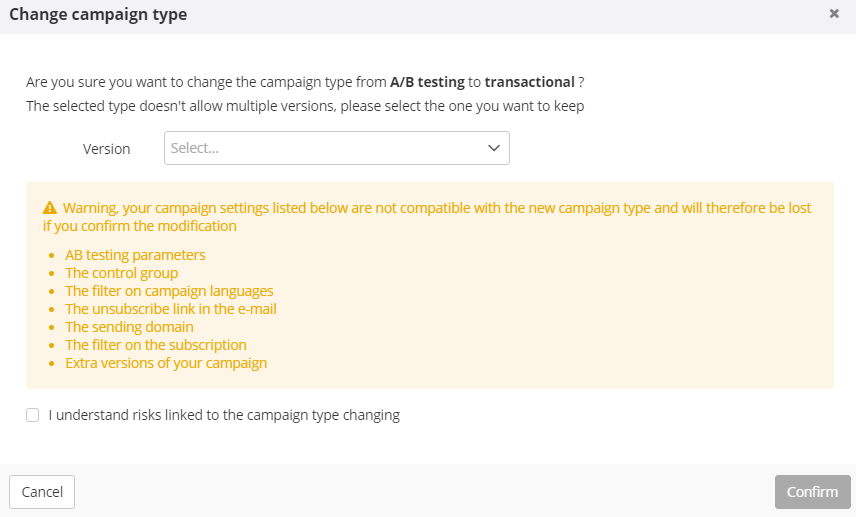
Step 1: General data
At this step, you will be able to define the base data of your
e-mail campaign.
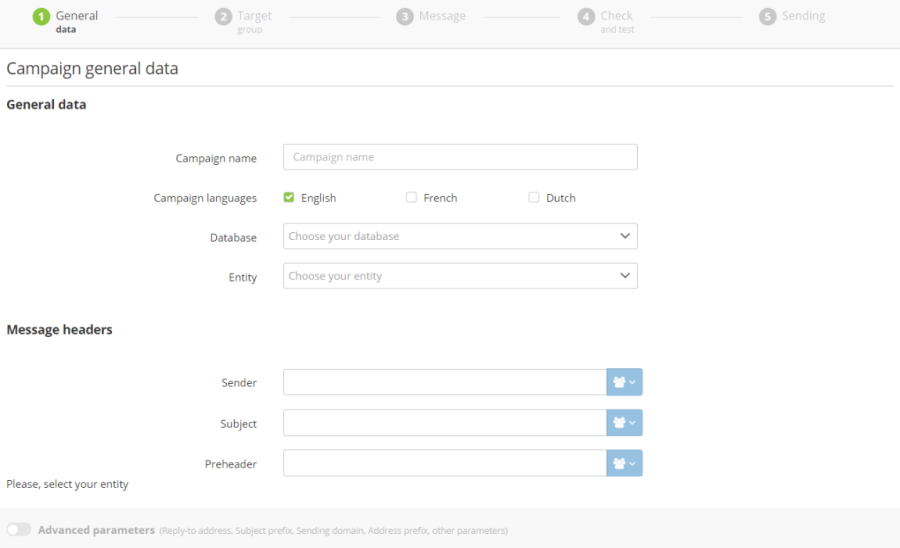
General Data
-
Campaign name: Specify the
technical that your sending will take in ACTITO. This will
have no impact on the text that the recipients will see.
Tip
We advise you to use a naming convention clear to every
team (for example: dateCampaignName).
-
Campaign languages: Choose the
language(s) of your campaign.
Tip
ACTITO allows you to prepare a single campaign and to
translate it in several languages, as long as your
licence is set-up for multi-lingual use. Please note
that modifying language parameters while editing your
message can affect already created content.
Advanced parameters
It is possible to define additional parameters regarding the
campaign technical configuration. To do so, click on the On/OFF
button at the bottom of your screen: this will display the list
of advanced parameters.
This ON/OFF button is only available after specifying the
entity.
The advanced parameters are organized in the following sections:
1.E-mails reply: You can specify a
'reply-to address' and a subject-prefix specific for this
campaign.
a. A reply-to address is the address where you
will receive all the replies to your campaign. It's important to
verify that this kind of emails are allowed by your webmail, so
that they are not filtered.
If no reply-to address is specified, you will not receive any
replies from your contacts
There are two options regarding e-mail replies :
-If Tracking replies is ticked
ON
When someone replies to your campaign, they won't see
your reply-to address, but a unique address for the interaction
(made of your licene name and a string of characters).
Indeed, the reply will transit through an Actito server, which
will enable Actito to update the profile interactions and
indicate that they replied to the campaign.
Following that, the Actito postmaster server will transfer the
e-mail reply to your selected reply-to address.


In this example, the reply will be sent to 'support@actito.com', although, when writing the reply, the user will see the
unique interaction address, in this case
'sales_training_rsctw-sht@campaign.actito.email'.
-If Tracking replies is ticked
OFF
Actito will not track replies, meaning that the information
whether a profile replied to the campaign will not appear in
their interaction.
However, the address that will appear when someone replies to
your e-mail campaign will be directly your reply-to address,
without intermediary.
Additionally, when replies are not tracked, it is possible to
use a personalization, for example to directly transfer the
reply to the appropriate customer representative.


In this example, the user will see the value of the
personalization (it must be a valid e-mail address) and the
reply will be sent directly to this address.
-
-
Subject prefix: It's the prefix that
will appear on the reply email subject.
If your campaign's subject is 'Season essentials' and
your reply prefix is your 'Enquiry', the subject of the
reply that you receive will be 'Enquiry - Season
essentials'.
-
Sender e-mail address: You can
specify a sending domain and an address prefix for your
campaign.
-
Sending domain: You can choose among
the sending domains available in your licence.
-
Address prefix
: When a fixed "from" is in place for your
license, this option allows you to replace the sending
prefix (which is the part of the e-mail address before
the @) by a specific value chosen for this campaign

Please note that special characters are not allowed
and that a maximum of 20 characters is allowed.
Tip
If you would like to have a default fixed
"from" configured for your license, don't
hesitate to contact Actito support.
-
Links: You can select the domain
of the links of your e-mail among the domains available in
your licence.
-
Impact on commercial pressure:If
you have commercial pressure rules in your licence, you can
specify the weight of your campaign. By default, the e-mail
is recorded normally, but it is possible not to record it
(such as for transactional e-mails) or to record them double
if it is a high impact e-mail.
-
Campaign groups: You can add this
campaign to an existing campaign group.
Tip
Grouping similar campaigns together allows you to analyze
the results of this campaign group as a whole.
6. Goals: You can choose to enable
goal tracking or not for the campaign.
If goals are enabled, goal query parameters will be added to the
URL of each link of your e-mail, to interact with the goal
script. By default, goals are enabled.
Step 2: Target population
This step allows you to choose with whom you want to communicate.
Subscription and languages
As aspects related to subscriptions
are paramount, it is mandatory to specify them.
Next, you
will be able to choose which
unsubscribe scenario is used.
E-mails will only be sent to profiles whose
language (defined by the
'motherLanguage' attribute) was chosen for the campaign at step
1, unless you uncheck the 'Language' box.
In this case, you
can select a default language. This will allow you to contact
profiles whose language is not included in the languages of your
campaign.
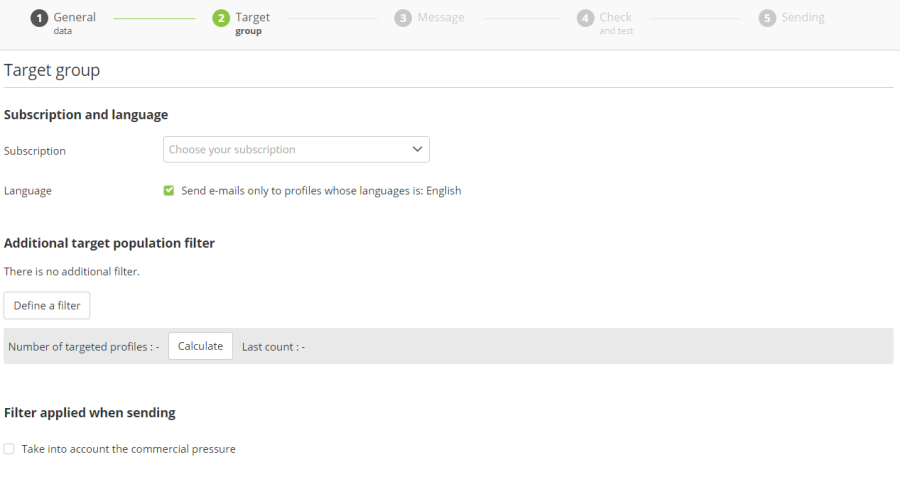
You must ensure to always have the authorization of your
contacts to send them communications. You must therefore
specify the subscription taken into account for this
campaign.
As a result, only profiles subscribed to this
subscription will receive this campaign. If a contact
unsubscribes following this campaign, only the subscription
related to it will be impacted.
Additional filter on target population
You can define additional filters to limit the target
population. To do so, click on the 'Define a filter' button. The
targeting module will open in a pop-up window. Comprehensive
explanation regarding this module are available in the
'Targeting' chapter of the online
documentation.
Number of profiles in the targeting
After setting up your filter, you can calculate the number of
profiles targeted.
By clicking on the 'Calculate' button,
you will launch an estimation of the target. You will therefore
obtain the number of people who match your criteria and to which
the e-mail will be sent.
Filters applied at sending

If there are commercial pressure rules in your
licence:
The filter of commercial pressure, which you defined at the
previous step, is not applied by default. If you want to take
into account your commercial pressure rules, it is necessary to
check the relevant box.
Please note that the commercial
pressure filter will not be applied in the target estimation
If the e-mail address is not a unique attribute in your
database:
It means that several profiles can have the same e-mail address.
Check the box "Send only one e-mail by e-mail address"
to avoid sending the same e-mail twice. The profile (and
therefore the personalizations applied to the message) will be
selected randomly.
Step 3: Message
During this step, you will be able to choose the creation mode of
your new e-mail campaign:
The available options are:
A template library is provided by ACTITO. This is the simplest
option, which does not require knowledge of HTML. For a detailed
explanation about this option, we invite you to read the chapter
on "Creating an e-mail via a template".
You can import either:
-
An HTML file, which contains images in absolute (hosted on a
third party server)
-
A ZIP file, containing one or more HTML files according to the
number of languages in the campaign. It is advised to use one
HTML file and one image file per language. The maximum size of
the ZIP is 4 Mb. We advise that each image should not weigh
over 200 kb.
When you choose to code your own HTML, the basis of the code will
be provided. This will predefine the encoding and the style of
your e-mail.
Tip
Even if you choose to import or code your HTML, it is still
possible to use personalization in ACTITO. You only need to
use the appropriate $ tag.
Personalizing the message
ACTITO lets you personalize your e-mails in order to display
text elements specific to each of your contacts. This can call
on attributes of the Profile table, but also on various other
data.
To insert a personalization, type the $ tag followed
by the name of your personalization between curly brackets (for
example, $firstName) where you want your personalization to
appear in your message. When the recipient will receive the
e-mail, this tag will be replaced by the corresponding value for
their profile.
For detailed explanations about personalizations in e-mails, we
invite you to read the page on
"Personalizing or Conditioning an E-mail".
Tip
It is not allowed to use special characters or spaces in the
technical name of personalizations. For instance,
${firstname} must be used instead of ${first name}.
Check links
After writing your message and defining personalizations, it is
necessary to go to the link checking step.
To do so, click
on the "Check links" button in the message preview
screen.

You will reach a new page which will contain the list of every
link found in your e-mail.
This list includes:
-
The link of the text
-
The URL of the link or the personalization towards which
it directs (in the case of a form or an unsubscribe link)
-
The name of the link: this is the name which will appear
in the reporting
-
The status of the link: an icon to the left tells you
-
Green icon: the link is working properly
-
Red icon: the link directs to a page that cannot be
reached
-
Grey icon: This is a technical value that cannot be
tested (for example, an ACTITO URL of a form, the
webversion or the unsubscribe link
Tip
A red status does not necessarily indicate an error. Other
reasons are possible, for example if authentication is
needed to reach the page, a pop-up blocks access to the page
or if the url has special characters but was not percent
encoded.
It should be understood as a warning to double-check this
link in your test e-mails.
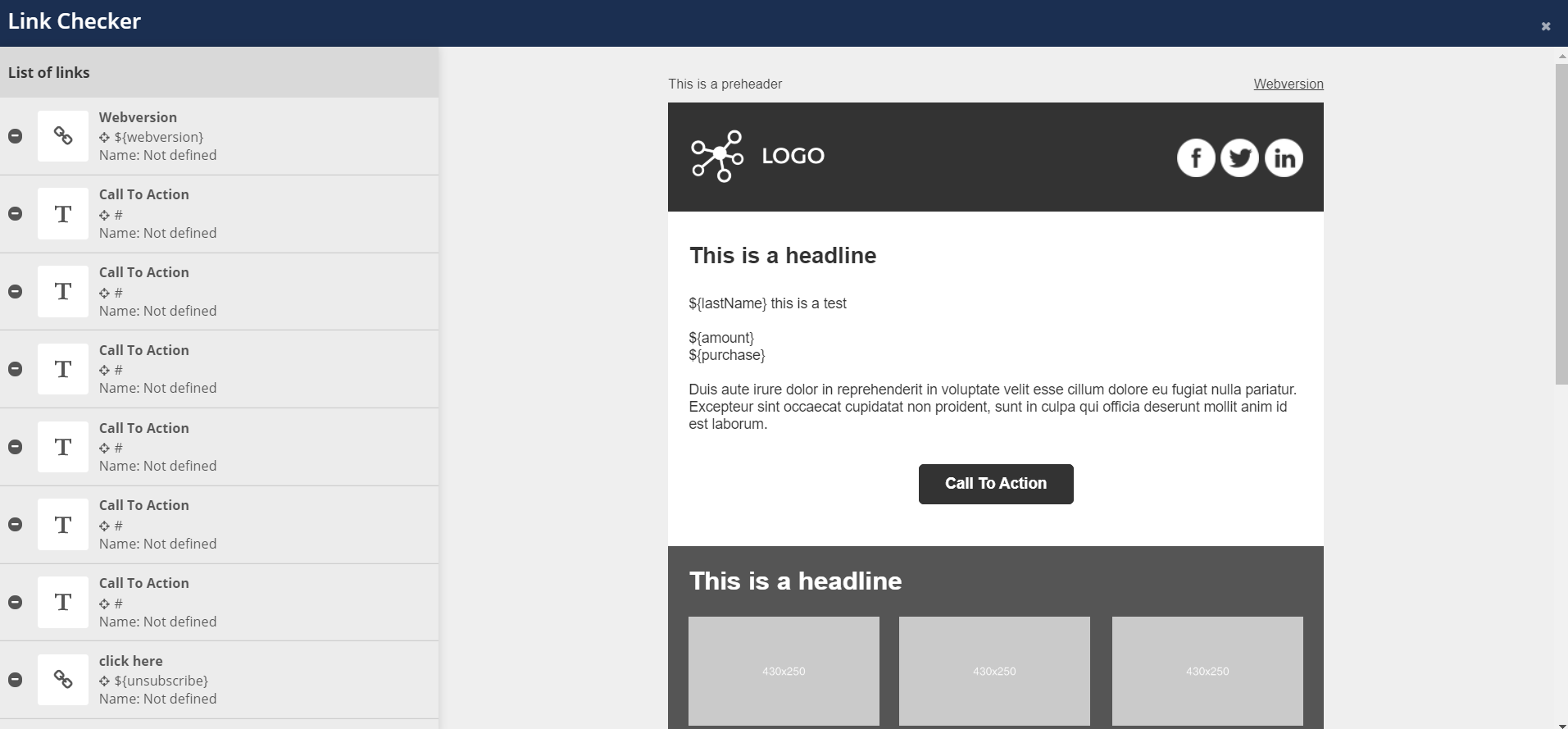
Hover each link in the list to the left to highlight its
location in the e-mail.
Click on each link to define their name. This technical name is
different from the title of the link. It is used in reporting.
It will help you differentiate each of these links in order to
easily find them in statistics related to each campaign. If you
leave the name of the link empty, the full url will be displayed
in the sending report.
You do not need to click on the small "pen" icon to
edit this link. Clicking on the tab of each link is enough the
technical name settings.
Tip
To facilitate the analysis of clicks in your e-mails, each
link should have a different name. However, if there similar
links between campaigns, it is better to keep the same name
in order to be able to carry out a global analysis (for
example: pre-header, facebook,…).
After checking all your links, click on the X in the top right
corner to leave the link checking screen.
Links parameters (UTM,...)
After the creation of your message, you will be able to set up
the additional url parameters.
They allow you to define generic parameters of web traffic
analysis tools, such as Google Analytics, which will be added
to each link of your campaign. Thanks
to this information, you will be able to measure the efficiency
of your marketing strategy and to compare the result of your
communications.
It is of course possible to use any other traffic analysis
tool, by manually entering the tags used by these other
solutions.
To set them up, click on the "Links parameters
(UTM,...)".

Next, you will be able to enter the additional parameters:
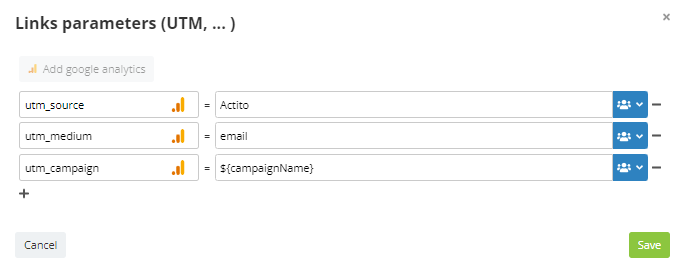
Click on the "Add google analytics" button to prefill
the 'UTM' parameters, used with the most popular tool, namely
Google Analytics.
-
utm_source: allows to identify
the source of the publication which generates traffic
towards this link
-
utm_medium: allows to identify
the marketing channel (in this case: e-mail)
-
utm_campaign: allows to identify
the name of a campaign
The two other existing parameters (utm_content and utm_term) are
optional.
It is possible to add personalizations to the URL parameters
by using the blue buttons or the ${variable} format. By
default, a personalization corresponding to the campaign
name will be used for utm_campaign.
A maximum of 8 parameters can use personalizations with this
feature. Remember that it adds the parameters to all links
of the e-mail: if you need to push profile attributes to
pre-fill a form on your website, for instance, more
parameters can be added to the individual link.
Step 4: Check and Test
At this stage, you will be able to check the rendition of your
e-mail campaign depending on the personalizations and conditions
you included.
Tip
If your internal validation processes for e-mail campaigns
require sending various versions to several witness persons,
you will be able to do it there.
Choose the testing group that you want to use to carry out your
tests.
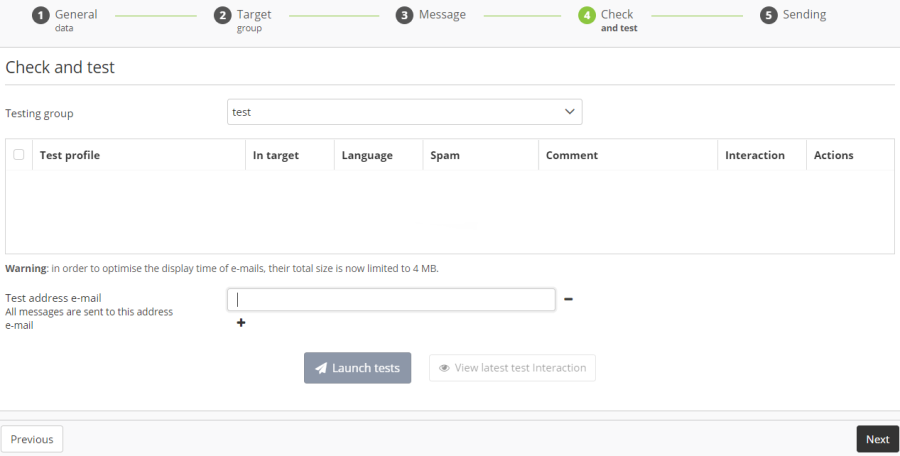
For additional information on testing groups, such as how to
set them up and how to use them, we invite you to read
the section dedicated to them.
After choosing the relevant testing group, you will be able to
select test profiles then to specify a "Test e-mail address". The e-mails will be only sent to the given address
instead of every selected profile, while applying personalizations
specific to them. It is possible to specify more than one
redirection addresses.
If the message must be validated by different people, we
advise you to send it to them at this stage, rather than
forwarding the very same test message to everyone. Forwarding
test emails may affect the email's layout and images.
With the button "View latest test Interaction", you can
directly check the status of your test e-mail for each profile of
your testing group, without having to use the "Profiles"
module.
Tip
Avoid clicking on unsubscribe links during this step unless
you want to test this feature. Unsubscribing in a test e-mail
will be really taken into account for each test profile.
Checking the size of the e-mail
When sending a test e-mail, Actito will the display the size of
this e-mail. This is an important parameter, as some webmails
(especially Gmail) will clip your message if it is over the 102
KB limit.

It is bad user experience and a risk that the recipient doesn't
view the entire message. It is therefore important not to go
over this limit.
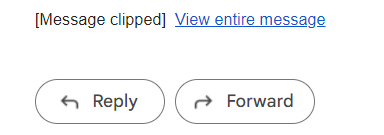
The 102 KB limit enforced by Gmail is only related to the
code if your e-mail, so the HTML
content without images.
It is a different limit than the 4 MB one, which is related
to the entirety of the e-mail, with images, and which exists
to
optimize the loading time
of your e-mail.
Depending on the size of the test e-mail, a green, orange or red
color code will inform you whether your message risks being
clipped.
-
Green
: below 97 KB, there is no risk of the message being
clipped.
-
Orange
: if the e-mail is just below the limit (between 97 and 102
KB), the test e-mail will be displayed entirely but we
consider there is a risk of the message being clipped for
some profiles. Why? The limit is
related to the e-mail content, after the calculation of
personalizations, the link encryption, etc. If the e-mail
contains a lot of personalizations, the content of some
profiles could be longer than that of the test e-mail. One
should therefore pay attention if close to the limit.
-
Red
: above 102 KB, the e-mail will be clipped and you can
expect that all the targeted profiles won't see the entirety
of the message.

Speaking of link encryption, we know that the redirection
URL of your links (used to track clicks) can sometimes be
very long, especially when it contains lots of additional
parameters (UTM, goals,...). It contributes to the content
size.
This is why Actito has developed a new encryption method of
tracking URLs. They are now shorter (especially when the
link contains many URL parameters), while keeping the same
level of security as before.
The new shorter encryption method can currently be
activated on demand (by e-mail to
support@actito.com).
Step 5: Sending
If the content of your e-mail campaign does not contain any
mistake, you will reach the Sending screen.
If everything is not correctly defined in your campaign, ACTITO
will not let you validate the sending, in order to prevent you
from sending a campaign which contains errors. Instead, an error
message will be displayed. It will detail problems encountered
with your campaign, in order to let you correct them.
A summary of every information specific to the campaign will be
displayed. You will be invited to check:
-
The general data, including the message headers and the
general parameters
-
The target group (subscription, language and targeting
criteria)
-
The message warnings : if you did not check some elements,
or if there are incorrect or non-standard elements, a
warning will be displayed under the "Message"
section. Comments in yellow (i.e. not-checked links, ignored
HTML rule) are non-blocking. Comments in red (i.e. missing
personalization) are blocking.
If all elements are correct, you will be able to send the
campaign.
Marketing E-mail
Advanced parameters
In mass campaigns (One-shot and A/B test emails), you are able
to toggle some advanced parameters.

Control group
You can set up a control group by selecting either a
percentage or an absolute number of profiles.
A control group is a population sample to which the campaign
will not be sent, in order to
compare its efficiency with the behavior of profiles who did
not receive it.

It is possible to find the list of profiles filtered in the
control group by using the "E-mail" targeting
module.

Sending speed
By default, the sending speed is set to normal, but it is
possible to use the "(very) slow" mode, to avoid
generating too much traffic at once on your website, or the
"fast" mode, to pre-generate the campaign.
Learn more about the additional
"Sendind speeds".
Tip
Fast and (very) slow sending speeds are specific right
that must be activated in your licence.

Report e-mail notification
If you need to share the results of your campaign with
analysts or executives who do not have have access to
Actito, you can choose to automatically send them an e-mail
notification with a link to the report.
The report will be exactly the same as the report found in
the user interface, except it is hosted outside of your
Actito licence.
Just like the standard report, it will be dynamic, meaning
that actions from your recipients will update the report.
For this reason, you may want not to send the report right
after the campaign is finished. You have the option to send
the report after 0 (right when all e-mails have been sent),
1, 2, 3 or 7 days.

Sending
If you created a Marketing e-mail (mass campaign), you will
have the choice between:
-
Send now: Send immediately,
without delay, as soon as you click on the button.
-
Schedule later: You can
define the date and hour when your campaign will be
sent. By scheduling the campaign at a later date, you
make sure that your campaign will be effectively sent,
without having to do anything later.

Timezone management
By default when you plan a campaign, the sending time will
be calculated according to the timezone of your internet
browser (displayed under the date picker). If you need to
plan a campaign on another timezone, click on the
"World" icon.
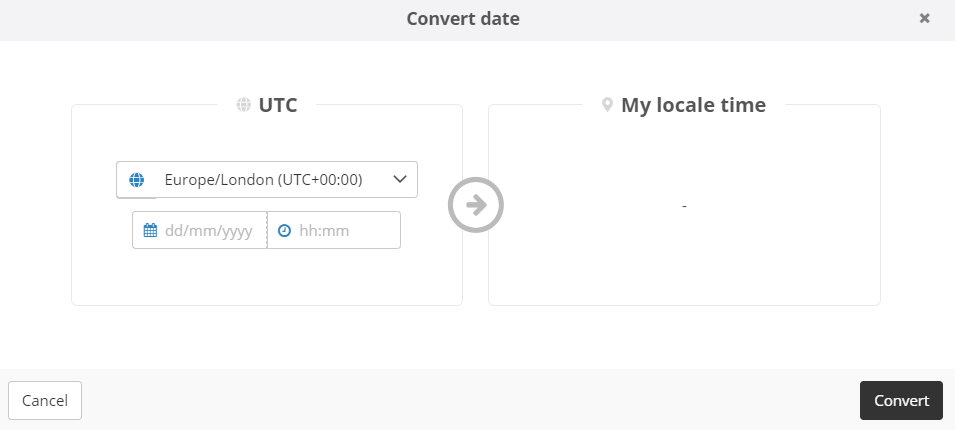
You will be able to convert any timezone into your local
time.
Scenarized and Transactional E-mails
If you decided to create a continuous campaign (scenarized or
transactional), you will be able to choose the
"Activate sending" option.
The e-mail will therefore be available for sending automation,
such as planning scenarios.

Save as template
During this step, it is possible to save a
campaign template.
It is advised to use them should you want to facilitate the
set-up of similar campaigns.
To do so, click on the button at the very bottom of the page:
"Save as template"
































